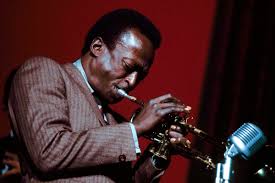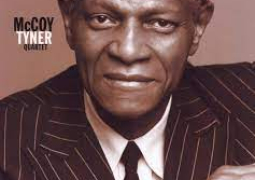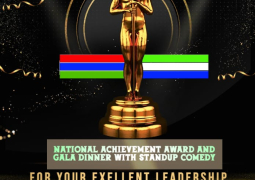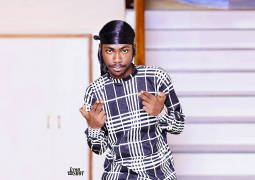
He is one of the most influential musicians of the 20th Century and has traversed the jazz scene from mainstream to funk. His birth-name is Miles Dewey Davis, and he was born in Alton, Illinois on May 26th1926 to a relatively well to do family of Dr. Miles Henry Davis and Cleota Mae Davis. His father was a dentist and his mother a cultured woman who enjoyed playing the piano during her private moments. Mile’s musical career was much encouraged by his father who gave him a trumpet at the age of thirteen and arranged lessons with a local musician called Elwood Buchanan. It was Mr. Buchanan who emphasized the importance of playing without vibrato, which helped Miles develop his own signature tone throughout his career. He was also greatly influenced by another great trumpeter, Clark Terry.
Miles became a professional musician at the early age of sixteen while still in high school. He graduated from high school in 1944 at the age of eighteen, and it was during this period that his life would change forever as he gets submerged in the world of jazz. Although he was born in Illinois, his family moved to East St. Louis in the neighboring state of Missouri, and it was here, where he would meet for the first time, jazz greats Dizzy Gillespie, Art Blakey, Charlie Parker and Billy Eckstein. Miles described hearing Gillespie and Parker play together as “the greatest feeling I had in life-with my clothes on”. Soon after this experience, he moved to New York and again with his father’s support, he enrolled at the famous Julliard School of Music. He did not stay long at this school, complaining of too much concentration on the classical European and “white” repertoire. He however acknowledged later, how Julliard helped him get firm grip on the theoretical aspects of music.
While in St Louis, Miles was busy looking for Charlie Parker so that he can rekindle that first experience he had in St Louis when he first met Parker. He also spent time performing with several jazz combos and played the 52nd street club circuit with Coleman Hawkins and others. In 1945, Miles had his wish come through when he was hired by Charlie Parker to replace Dizzy Gillespie on trumpet. This opportunity again gave him the chance to meet and work with another legend, the great drummer Max Roach. The band toured the United States for a while, but disintegrated in Los Angeles when Parker had a nervous breakdown and had to be admitted for treatment. During this period, Miles worked mainly as freelance musician.
In 1948 he met and became very close to the Canadian composer and arranger Gil Evans, this led to the creation of a new group and an unusual line-up including a French horn and a tuba. The group was initially made up of Miles on trumpet, Max Roach on drums, John Lewis on piano, Gerry Mulligan on baritone saxophone and Bill Barber on tuba. They were active for a brief period undergoing several changes in personnel, but it marked the beginning of a new style in jazz called “Cool Jazz”. This development was also seen as a response to the increasingly “virtually instrumentalism” which was dominating the bebop scene at the time, and both Evans and Miles were unhappy with the trend. In the 1950’s, Miles travelled to France and visited Paris, the cultural environment in Paris where jazz musicians were more often better appreciated and respected than in their homeland, fascinated him. He was tempted to stay there, but decided to return to New York, a return that would lead him into the dark alleys of drug addiction and depression. He was depressed in part in part, because of the lack of appreciation he felt from the music critics who were hailing some of his former collaborators as the pioneers of the “cool Jazz” movement. His drug addiction was due to the company he kept, as most of his associates at that time had developed drug habits of their own. However, in spite of all this personal turmoil, the period between 1950 and 1954 was a fruitful one artistically.
In 1954, Miles moved back to his hometown of St. Louis and was able to detach himself from the bad influences that had affected him. He kicked his drug habit and collaborated with many important musicians in Detroit and nearby cities. It was during this period that he was introduced to the music of Ahmed Jamal whose use of space and beautiful approach took effect on Miles. He would later meet Bob Winstock, owner of Prestige Records who signed him on for a series of recordings. He began using the Harmon mute which was held close to the microphone, and it became his signature tune and his ballads became more spacious, melodic and relaxed, something he adopted from Ahmed Jamal. Some important recordings were made with Prestige Records comprising of songs made between 1950 and 1954. He became much focused but gained the reputation of being cold and distant. It was during this period that liner notes of his records began referring to him as “The Prince of Darkness”.
In 1955, with his new found energy, he played with a lot of younger musicians including John Coltrane, Paul Chambers, Red Garland and Philly Joe Jones. By the end of that year, he was elected as the best trumpeter in the annual popularity poll conducted by Downbeat Magazine-one of the leading journals in jazz. The following years will see Miles change record companies and sign with Columbia Records. He would constantly develop new style and innovate new methods, always trying to be one step ahead of what was happening. The story of Miles Davis is a long one with many experiences, and cannot be covered in this space his later years are also very intriguing and will make good reading.





